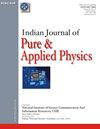KOH活化法合成玉米芯活性炭及表征
IF 1.1
4区 物理与天体物理
Q4 PHYSICS, MULTIDISCIPLINARY
引用次数: 0
摘要
农业废弃物的大量产生造成了严重的环境污染问题。目前的工作重点是发展具有成本效益和生态友好的废物处理办法。农业废弃物含碳量较高,可作为生物炭和活性炭前体。在本研究中,以玉米芯生物质为原料,采用不同温度(600℃;800℃采用氢氧化钾活化。利用x射线衍射、紫外-可见光谱、红外光谱和N2吸附/脱附等温线等技术对合成材料进行了表征。FTIR研究鉴定了官能团,XRD分析揭示了所制备材料的结构。FE-SEM图像表明,生物炭的活化形成了具有不同形状和大小孔隙的多孔活性炭。BET分析表明,在800℃温度下,AC的高比表面积为575 m2/g,孔体积为0.291 cm3/g。利用紫外-可见吸收光谱测定的光学带隙表明,吸收边缘位于光谱的紫外区。本研究的结果强调了利用农业废物作为有效的前体以最小的费用生产活性炭的潜力。这种碳变体在水净化,金属回收,能源设备等各种应用中显示出前景。本文章由计算机程序翻译,如有差异,请以英文原文为准。
Synthesis and Characterization of Activated Carbon from Corn Cobs using KOH Activation
The enormous production of agricultural waste has created major problems for polluting the environment. Current efforts are focused on developing cost-effective and eco-friendly alternatives for disposal of waste materials. Agricultural wastes might be utilized as biochar and activated carbon (AC) precursors due to their higher carbon contents. In the present study, the activated carbon derived from corn cob biomass has been prepared successfully by the pyrolysis method at different temperatures i.e. 600 & 800 °C using potassium hydroxide activation. The synthesized materials (AC) were characterized using different techniques like X-ray diffraction, UV-Visible Spectroscopy, FTIR and N2 adsorption/desorption isotherm. The FTIR study identified the functional groups and XRD analysis revealed the structure of the prepared material. The FE-SEM images showed that activation of biochar resulted into formation of porous activated carbon with various shapes and sizes of pores. The high surface area 575 m2/g and pore volume 0.291 cm3/g of AC at 800 °C temperature were observed with BET analysis. The optical band gap determined using UV-Vis absorption spectroscopy indicates that the absorption edge lies in the ultra-violet region of the optical spectra. The findings of the present study highlight the potential of utilizing agro-wastes as effective precursors for producing activated carbon with minimal expenses. This carbon variant shows promise in various applications such as water purification, metal recovery, energy devices, etc.
求助全文
通过发布文献求助,成功后即可免费获取论文全文。
去求助
来源期刊
CiteScore
1.30
自引率
14.30%
发文量
42
审稿时长
7 months
期刊介绍:
Started in 1963, this journal publishes Original Research Contribution as full papers, notes and reviews on classical and quantum physics, relativity and gravitation; statistical physics and thermodynamics; specific instrumentation and techniques of general use in physics, elementary particles and fields, nuclear physics, atomic and molecular physics, fundamental area of phenomenology, optics, acoustics and fluid dynamics, plasmas and electric discharges, condensed matter-structural, mechanical and thermal properties, electronic, structure, electrical, magnetic and optical properties, cross-disciplinary physics and related areas of science and technology, geophysics, astrophysics and astronomy. It also includes latest findings in the subject under News Scan.

 求助内容:
求助内容: 应助结果提醒方式:
应助结果提醒方式:


